
Stylidium is a genus of dicotyledonous plants that belong to the family Stylidiaceae. The genus name Stylidium is derived from the Greek στύλος or stylos, which refers to the distinctive reproductive structure that its flowers possess. Pollination is achieved through the use of the sensitive "trigger", which comprises the male and female reproductive organs fused into a floral column that snaps forward quickly in response to touch, harmlessly covering the insect in pollen. Most of the approximately 300 species are only found in Australia, making it the fifth largest genus in that country. Triggerplants are considered to be protocarnivorous or carnivorous because the glandular trichomes that cover the scape and flower can trap, kill, and digest small insects with protease enzymes produced by the plant. Recent research has raised questions as to the status of protocarnivory within Stylidium.

Stylidium scandens is a dicotyledonous plant that belongs to the genus Stylidium. S. scandens is endemic to Australia and is found primarily in the southwestern region of Western Australia. This species, along with Stylidium nymphaeum, has a unique characteristic among triggerplants in that its leaves, five centimetres long, end in a recurved barb that can grab hold of other vegetation and scramble or climb up to 30–60 cm in height over other plants, which is how it obtained its common name. Its flowers are bright pink and about 15 mm wide.
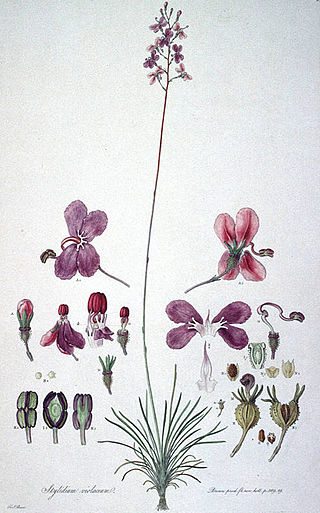
Stylidium violaceum, the violet triggerplant, is a dicotyledonous plant that belongs to the genus Stylidium. S. violaceum is endemic to Australia and is found primarily in the southwestern region of Western Australia. It can grow up to 50 cm including the scape. The mostly purple flowers are 10 mm tall and 6 mm broad. Leaves are 5 cm long and about 4 mm broad. Flowering occurs mainly from October to January. S. violaceum is found in locations with sandy or loamy sand soil texture conditions on hillslopes, dunes, or winter wet depressions and swamps.
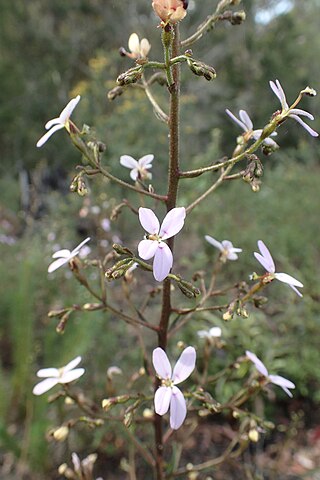
Stylidium laricifolium, commonly known as giant trigger-plant, larch-leaf or tree triggerplant, or is a species of flowering plant in the family Stylidiaceae and is endemic to eastern Australia. It is a perennial subshrub with many linear leaves crowded along its few stems, the flowers white to pale pink and arranged in a single main panicle and smaller racemes.

Stylidium adnatum, commonly known as the common beaked triggerplant, is a species of flowering plant in the family Stylidiaceae and is endemic to the southwest of Western Australia.

Stylidium repens, the matted triggerplant, is a dicotyledonous plant that belongs to the genus Stylidium. S. repens is endemic to Australia and is found primarily in southwest Western Australia. This species is a creeping or scrambling triggerplant, which can spread over large areas as a tangled mat of stems and aerial roots. The older stems are grey whereas younger stems appear red and have terminal rosettes of small leaves, five mm to one cm in length. When the rains come, new roots and a one to three flowers emerge from the terminal rosettes. This is the only species of triggerplant known to regularly flower twice a year—in autumn and late spring. Pollination, which is typically very specialized in this genus, is achieved with a variety of insects in this species.
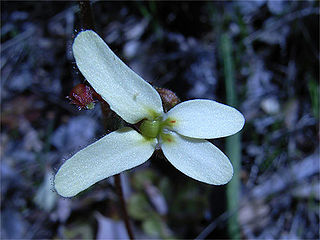
Stylidium hispidum, the white butterfly triggerplant, is a dicotyledonous plant that belongs to the genus Stylidium. S. hispidum is endemic to Australia and is found primarily in southwest Western Australia near Perth. This species is a basally rosetted triggerplant with greyish, linear leaves growing up to three cm. The scape is reddish, from six to thirty cm tall ending in a somewhat branched raceme giving rise to white or cream-colored flowers, which have red spots near the throat of the flower. The primary habitat for S. hispidum includes jarrah forests, gravelly loams, and light sandy soils.

A protocarnivorous plant, according to some definitions, traps and kills insects or other animals but lacks the ability to either directly digest or absorb nutrients from its prey like a carnivorous plant. The morphological adaptations such as sticky trichomes or pitfall traps of protocarnivorous plants parallel the trap structures of confirmed carnivorous plants.

Oreostylidium is a genus of flowering plants in the family Stylidiaceae with a single species, Oreostylidium subulatum, that is endemic to New Zealand. O. subulatum is a very small plant with small, white flowers. It has a complicated botanical history that has led to a few proposals to move Oreostylidium to the related genus Stylidium. The researchers cite molecular data and suspect that this species is an extreme example of floral paedomorphosis. This would not be an unprecedented move since the single species was initially described as Stylidium subulatum in 1864 and later moved to its own genus by Sven Berggren in 1878. It possesses the same kind of glandular trichomes underneath the flower that make Stylidium species carnivorous plants, but it has not yet been tested for the presence of digestive enzymes.
Repentes is a section in the subgenus Tolypangium. Repentes is a group of creeping triggerplants known as the locket triggerplants, related to subgenus Nitrangium section Appressae. They possess adpressed stem leaves bearing a small basal spur and uni-flowered inflorescences. Because section Repentes morphologically resembles the other creeping triggerplants in section Appressae, Allen Lowrie et al. (1999) proposed all species in this section be moved to section Appressae and Repentes be placed into synonymy. Juliet Wege (2006), however, argued that these species are morphologically distinct from those in section Appressae, citing trichome and column cunabulum structure as distinctions that separate the sections.
Stylidium schizanthum is a dicotyledonous plant that belongs to the genus Stylidium that was described by Ferdinand von Mueller in 1859. It is an erect annual plant that grows from 9 to 30 cm tall. Obovate, orbicular, or oblanceolate leaves, about 3-13 per plant, form basal rosettes. The leaves are generally 3.5–23 mm long and 1.5–12 mm wide. This species generally has one to four scapes and cymose inflorescences that are 9–30 cm long. Flowers are white, pink, mauve, or yellow. S. scizanthum's distribution ranges from the Kimberley region in Western Australia through the Northern Territory and into northern Queensland. It has been reported as far south as Mount Surprise and even in southern New Guinea. Its typical habitats are moist sand in Eucalyptus or Melaleuca communities, near creekbanks, or associated with sandstone landscapes. It flowers in the southern hemisphere from February to October. S. schizanthum is closely related to both S. pachyrrhizum and S. lobuliflorum.
Stylidium graminifolium 'ST111', also known under the tradename Tiny Trina, is a cultivar of Stylidium graminifolium that was selected for in 2001 by Todd Layt of Ozbreed Pty Ltd and granted cultivar status in 2005. Tiny Trina has a deeper pink flower colour and leaves that are a darker shade of green with varying leaf blade widths. It also begins to flower later in the season than the other S. graminifolium cultivar, Stylidium graminifolium 'ST116', known under the tradename Little Saphire.
Stylidium graminifolium 'ST116', also known under its tradename Little Saphire, is a cultivar of Stylidium graminifolium that was selected for in 2001 by Todd Layt of Ozbreed Pty Ltd and granted cultivar status in 2005. Little Saphire is of a shorter stature, has shorter but wider leaves, larger flowers, and a deeper blue-green foliage colour than the parent species. It also begins to flower earlier in the season than the other S. graminifolium cultivar, Stylidium graminifolium 'ST111', also known under its tradename Tiny Trina.
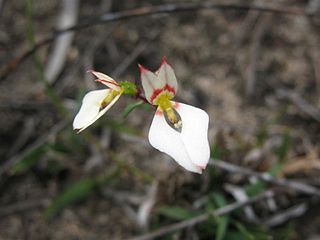
Levenhookia, also known as the styleworts, is a genus of ten recognized species in the family Stylidiaceae and is endemic to Australia. The genus is restricted to Western Australia almost exclusively with a few exceptions: L. pusilla's range extends into South Australia, L. dubia's range extends through South Australia into Victoria and New South Wales, L. sonderi is native only to Victoria, and L. chippendalei is also found in the Northern Territory.
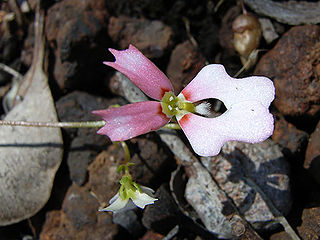
Stylidium calcaratum, the book triggerplant, is a dicotyledonous plant that belongs to the genus Stylidium. It is an ephemeral annual that grows from 5 to 10 cm tall but can grow larger at 20–30 cm tall in damp forest or scrub habitat. The few ovate leaves produced by this plant form basal rosettes around the stem. The leaves are around 3–5 mm long on short petioles. The scapes are 2–30 cm tall and produce single flowers in smaller plants and up to nine flowers in larger, more robust plants. Flowers are pink or white with red spots or lines at the individual petal bases. The petals are vertically paired and will fold over to meet each other at night or in adverse weather conditions. S. calcaratum is endemic to Australia and has a distribution that ranges from Victoria through South Australia and into Western Australia. Its habitat is recorded as being wet flats or near creeks and seepages. Pollination is achieved by a grey fly, Comptosia cuneata.
Stylidium ceratophorum is a dicotyledonous plant that belongs to the genus Stylidium. It is an annual plant that is endemic to the Kimberley region of Western Australia and northern parts of the Northern Territory. It attains a height of 12–30 cm with a basal rosette of small leaves. The leaves are petiolate, obovate, or lanceolate and are only 0.2–1 cm long. Solitary scapes are produced that bear golden yellow or orange flowers, 7–9 mm across. Its habitat has been reported as being sandy soils on creek margins in the presence of Stylidium rubriscapum and Stylidium diceratum or in river paperbark stands. S. ceratophorum appears similar to S. diceratum and may be confused with the species since they both have orange flowers. S. ceratophorum's corolla is twice as large as S. diceratum, though, as well as the deeply divided posterior corolla lobes of S. ceratophorum.

Stylidium perpusillum, the tiny triggerplant, is a dicotyledonous plant that belongs to the genus Stylidium, that occurs in south west Western Australia.
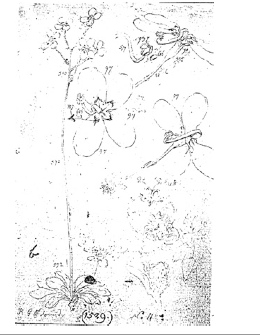
Stylidium spathulatum is a dicotyledonous plant that belongs to the genus Stylidium. The species is informally named the creamy triggerplant for the colour of its flowers.

Australia has one of the world's richest carnivorous plant floras, with around 187 recognised species from 6 genera.

















